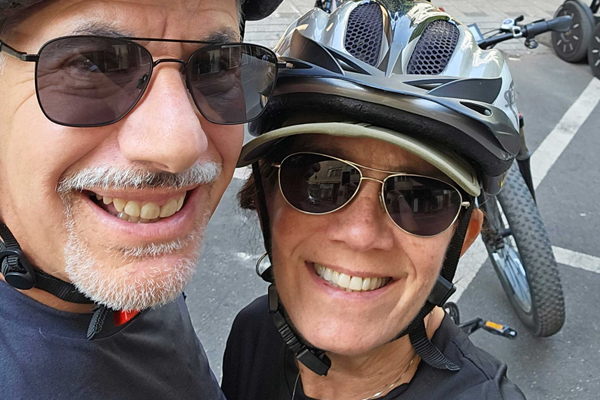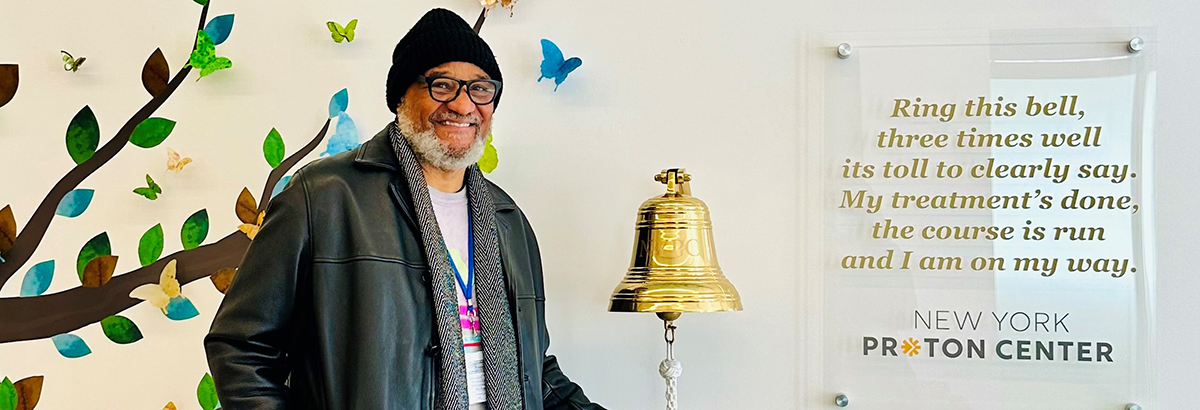Thymic Cancer: Meet Lisa
Resuming a Busy Life After Thymic Cancer
Balancing life, work, and health had always been easy for Lisa Grosswirth, an active 59-year-old woman from Freeport, Long Island who never let lifelong asthma interfere with her job as vice president of a bank or her passions for music, art and travel. That delicate balance tipped nearly two years ago, when after getting COVID-19, Lisa began to experience difficulty breathing that was getting worse with time. She was surprised to learn her symptoms were not due to COVID-19 or asthma, but to thymic cancer located deep in her chest. Lisa received lifesaving proton therapy at the New York Proton Center that effectively treated her cancer while avoiding harming her heart and lungs. Today, Lisa is cancer free and has resumed her busy lifestyle.
Symptoms Leading to an Unexpected Diagnosis
In May 2022, Lisa came down with a bad case of COVID-19 and began experiencing a cascade of debilitating breathing problems. “After I had COVID, I was having a lot of difficulty breathing, more so than with normal asthma,” says Lisa. “I would walk up 10 stairs and get extremely winded, as if I had just run a marathon. Sometimes I would get winded just from talking.”
Growing increasingly concerned, Lisa’s pulmonologist ordered several tests and altered her asthma medications, but nothing seemed to help. In December, suspecting that something besides asthma or the effects of having COVID was causing her symptoms, Lisa’s pulmonologist ordered a CT angiogram and delivered the unexpected news.
“My doctor told me they found a 4.2 cm tumor in my mediastinum,” says Lisa. “He suggested I get the tumor removed as soon as possible because it was very close to my heart and lungs. I was shocked to hear this because I had assumed my problems were due to asthma. I never expected I had cancer!”
Thymic cancer is a type of rare cancer that forms in the cells that cover the outside surface of the thymus, a small organ that lies in the upper chest above the heart and under the breastbone. The main treatments for thymic tumors are surgery followed by radiation therapy.
In January 2023, Lisa underwent surgery to remove the tumor, which was diagnosed as Stage 2A thymic cancer, which means the cancer had invaded the fatty tissue surrounding the thymus or the lining of the chest cavity.
“Although my surgeon said the margins were clear and he believed he got everything out, he recommended radiation therapy to kill any remaining cancer cells and lower the risk that the cancer would come back,” says Lisa. “I talked with my husband about it, and we agreed that radiation therapy would give us the peace of mind we needed.”
As Lisa researched her options for radiation therapy, she became worried about its risks and side effects. “The tumor was so close to my heart and lungs, so radiation really frightened me,” says Lisa. “I wanted to find a radiation expert who would provide the most effective treatment possible while minimizing any possible damage to these other organs.”
Lisa recalled an earlier experience with Memorial Sloan Kettering Cancer Center (MSK), one of the New York Proton Center’s partner hospitals. She explored the hospital’s website and found Dr. Charles B. Simone, II, Radiation Oncologist at MSK and Chief Medical Officer of the New York Proton Center, and an internationally recognized expert in treating thymic tumors, lung cancer, and other thoracic malignancies.


Minimizing the Damage of Surrounding Tissues: Proton Therapy Safely Targets Tumors
When thoracic cancer is treated with conventional radiation, it is difficult to deliver a high enough radiation dose to control the cancer without also impacting the normal lungs, esophagus, heart and spinal cord. Proton therapy can more effectively treat these tumors while better protecting critical normal structures from radiation. As a result, protons can minimize side effects such as lung inflammation (pneumonitis) or scarring (fibrosis), difficulty swallowing, heart complications, hospitalizations, and other side effects that are commonly seen with conventional radiation treatment.
“When I met with Dr. Simone, he explained the risks and benefits of traditional radiation therapy,” says Lisa. “Then he told me that he directs the New York Proton Center, and that proton therapy targets the actual tumor area, and nothing beyond that, so it is less risky.”
Lisa was relieved to learn how proton therapy would not only address her specific type of cancer, it would maximize her long-term health. “Dr. Simone told me that after radiation therapy, the odds of recurring cancer are exponentially decreased, and by using proton therapy, the odds of a cardiac complication or other toxicities later in life are significantly decreased,” says Lisa. “This sounded very good to me, so I decided to have proton therapy, because it matched my needs now and in the future.”
“Our goal for Lisa’s therapy was to reduce the risk of secondary malignancies and to prevent other late complications given her good long-term expected prognosis,” says Dr. Simone. “Compared to traditional radiation therapy, proton therapy would better protect and help avoid late toxicities to Lisa’s heart and lungs, which was very relevant in Lisa’s case given her pre-existing breathing difficulties.”
Before she could begin proton therapy, Lisa needed to obtain insurance coverage for the treatment. Dr. Simone and NYPC’s intake team helped Lisa every step of the way, including fulfilling a request by the insurance company to compare the risks and benefits of traditional radiation versus proton therapy. “Our analysis found that traditional radiation therapy would be expected to cause high risks of complications to the esophagus, lungs, and heart, but proton therapy would reduce the irradiation delivered to those organs, lowering the esophageal dose by nearly 60%, cutting the volume of the heart receiving high doses by more than half, and reducing the dose to the lung by 3-fold,” explains Dr. Simone.
A Focus on the Future
“Dr. Simone told me that after radiation therapy, the odds of recurring cancer are exponentially decreased, and by using proton therapy, the odds of a cardiac complication or other toxicities later in life are significantly decreased.”
Accommodating Treatment Schedule
In March, Lisa began 28 sessions of proton therapy. “Every evening for 28 days, my husband and I drove into the city,” says Lisa. “I never needed to take a day off from work. Other than feeling a little tired, I tolerated proton therapy very well.”
From her very first day at the New York Proton Center, Lisa felt right at home. “The minute I stepped in the door, everyone was so wonderful,” says Lisa. “I’ve never met such a nice group of people who were always asking me, How are you feeling? What kind of music do you want to hear during your therapy? and Do you want a blanket?”
“Shawn Giordano, the Clinical Unit Coordinator, was always so accommodating with my schedule, because he knew we were coming all the way from Long Island,” continues Lisa. “Chrissy Rubin, the social worker, helped me obtain a medical note for work and provided me with information about support groups. Alisa Ryncarz, the nurse practitioner, sent over a medical release form for a massage within five minutes of my request. They were all truly amazing!”
Now healthy and back to her active life, Lisa credits the New York Proton Center as instrumental to regaining her health and wellbeing. “The positive attitude of the entire staff at the New York Proton Center was truly contagious,” says Lisa. “Being a cancer patient, it’s really important to have a positive attitude throughout this journey,” says Lisa. “I wore socks with smiley faces on them, which made me and everyone around me laugh. Putting positive vibes out there really helps.



